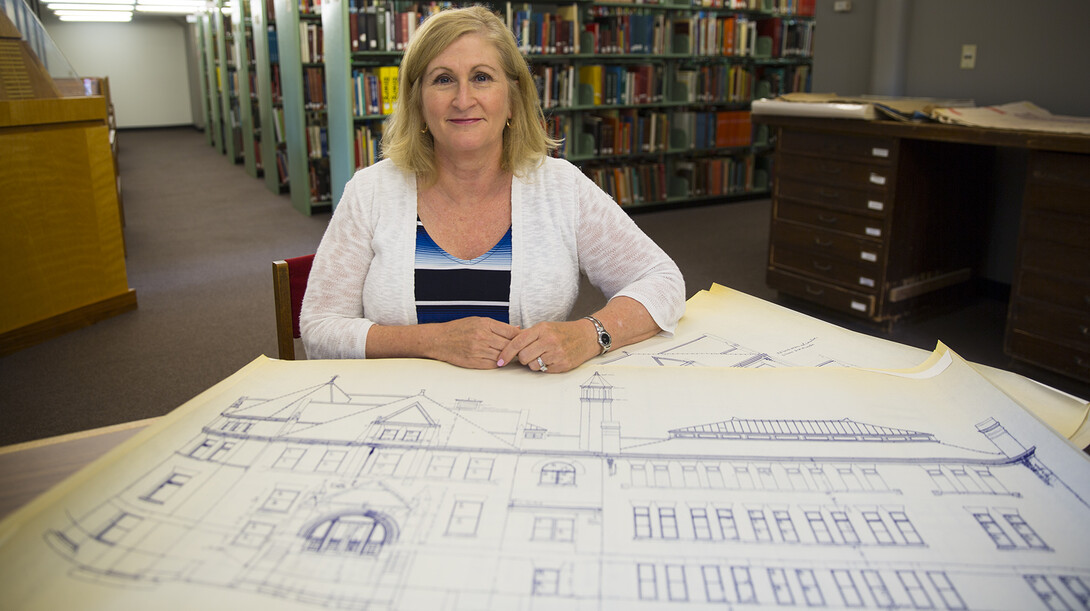
Campus architecture — and the people who shaped it — are helping Kay Logan-Peters tell the history of the University of Nebraska–Lincoln.
Based in the Architecture Hall library, the University Libraries professor regularly fielded student questions about the history of campus buildings. Inspired by those inquires and her own love for architecture, Logan-Peters spent nearly a decade gathering information to craft the UNL Historical Buildings website.
Launched in 2008, the website, which documents university buildings from 1869 to 1965, has led to Logan-Peters becoming a “very unofficial” campus historian.
“This project started out as a way to tell the story about the university and how it evolved and expanded over time,” Logan-Peters said. “The website has become a resource for campus and the public. It’s also led to regular referrals and requests for me to lead historical tours.”
She leads tours a handful of times each year, including one during UNL’s annual Jazz in June concert series.
Logan-Peters’ next walking tour is 5 p.m. Aug. 14. Organized by the Lincoln chapter of the American Institute of Architects, the tour (which is free and open to the public) will explore campus architecture from 1869 to 1925. The tour will begin on the front steps of Architecture Hall.
Logan-Peters’ website and tours include information on the architecture style of the buildings and the people who influenced construction.
“It’s not just about the architectural style of each building,” Logan-Peters said. “Every building and portion of campus has a story behind it. And, the details in those stories, from how the property was acquired to how buildings are named, are fascinating.”
In one of her favorite stories, Logan-Peters documented how Husker football defined the shape of UNL’s Brace Laboratory building in the early 1900s.
“Brace was to be a rectangular building, but its proposed location would have shortened the university’s first football field,” Logan-Peters said. “The athletic committee chair, C.R. Richards, raised a stink and insisted that the northwest corner of the planned building be cut out of the plans. Football prevailed and Brace was altered permanently.”
When Brace Labs was proposed in 1904, the Husker football team was riding a two-year undefeated streak.
“It’s really interesting that football was already an important and powerful factor in 1904,” Logan-Peters said. “It’s also interesting that D.B. Brace and the campus planning staff didn’t realize football wasn’t ‘just a game,’ and assumed that a new building displacing the field would be no big deal.”
In a final twist, the Mechanical Engineering Laboratory, which was named in honor of Richards, whose opposition led to the Brace Labs change, was built in 1908 on the original football field. The project came after the field shifted to what would become Memorial Stadium.
Logan-Peters’ research has also documented other interesting stories on campus history, including how donations from Charles Morrill, a long standing member of the university’s board of regents, influenced which architect would build the second Morrill Hall; and how the original Sigma Chi house moved when “Greek Row” was established in the 1920s with fraternities on the west side of 16th Street and sororities on the east.
Logan-Peters is now working to expand the historic buildings tour and incorporate information on buildings added between 1965 and 2000. She is also working on a proposal to develop a book that will feature historical campus photos.
“I’m a very unofficial campus historian,” Logan-Peters said. “But, developing this research has been a lot of fun. It also felt important to have someone pulling all these bits of information together into a single resource that tells the story of our university.”







